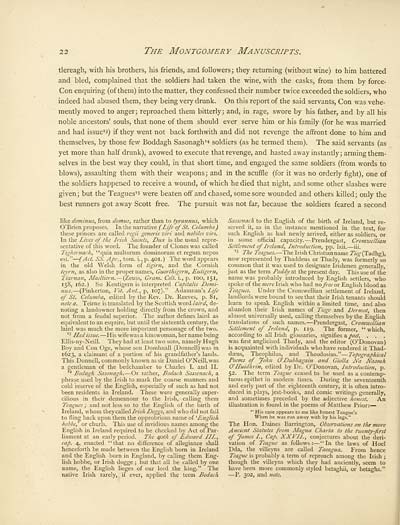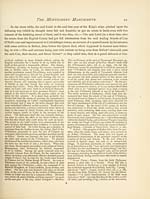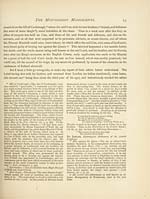Montgomery manuscripts
(36) Page 22
Download files
Complete book:
Individual page:
Thumbnail gallery: Grid view | List view

22
The Montgomery Manuscripts.
tlereagh, with his brothers, his friends, and followers; they returning (without wine) to him battered
and bled, complained that the soldiers had taken the wine, with the casks, from them by force.
Con enquiring (of them) into the matter, they confessed their number twice exceeded the soldiers, who
indeed had abused them, they being very drunk. On this report of the said servants, Con was vehe-
mently moved to anger; reproached them bitterly; and, in rage, swore by his father, and by all his
noble ancestors' souls, that none of them should ever serve him or his family (for he was married
and had issued) if they went not back forthwith and did not revenge the affront done to him and
themselves, by those few Boddagh Sasonagh 1 * soldiers (as he termed them). The said servants (as
yet more than half drunk), avowed to execute that revenge, and hasted away instantly; arming them-
selves in the best way they could, in that short time, and engaged the same soldiers (from words to
blows), assaulting them with their weapons; and in the scuffle (for it was no orderly fight), one of
the soldiers happened to receive a wound, of which he died that night, and some other slashes were
given; but the Teagues's were beaten off and chased, some sore wounded and others killed; only the
best runners got away Scott free. The pursuit was not far, because the soldiers feared a second
like dominus, from domus, rather than to tyrannus, which
O'Brien proposes. In the narrative (Life of St. Columba)
these princes are called regit generis viri and nobiles viri.
In the Lives of the Irish Saints, Dux is the usual repre-
sentative of this word. The founder of Clones was called
Tighernach, "quia multorum dominorum et regum nepos
est." — (Act. SS. Apr., torn. i.,p. 401.) The word appears
in the old Welsh form of tigim, and the Cornish
tcyrn, as also in the proper names, Guorthigcrn, Euligeru,
Tiarnan, Maeltiern. — (Zeuss, Gram. Celt, i., p. 100, 151,
158, 162.) So Kentigern is interpreted Capita/is Domi-
nus. — (Pinkerton, lit. Ant., p, 107)." Adamnan's Life
of St. Columba, edited by the Rev. Dr. Reeves, p. 81,
note a. Teirne is translated by the Scottish word laird, de-
noting a landowner holding directly from the crown, and
not from a feudal superior. The author defines laird as
equivalent to an esquire, but until the sixteenth century, the
laird was much the more important personage of the two.
13 Had issue. — His wife was a kinswoman, her name being
Ellis-ny-Neill. They had at least two sons, namely Hugh
Boy and Con Oge, whose son Uomhnall (Donnell) was in
1623, a claimant of a portion of his grandfather's lands.
This Donnell, commonly known as sir Daniel O'Neill, was
a gentleman of the bedchamber to Charles I. and II.
4 Bodagh Sasonagh. — Or rather, Bodach Sassenach, a
phrase used by the Irish to mark the coarse manners and
cold reserve of the English, especially of such as had not
been residents in Ireland. These were generally super-
cilious in their demeanour to the Irish, calling them
Teagues ; and not less so to the English of the birth of
Ireland, whom they called Irish Doggs, and who did not fail
to fling back upon them the opprobrious name of '■English
hobbe,' or churls. This use of invidious names among the
English in Ireland required to be checked by Act of Par-
liament at an early period. The ifith of Edward III.,
cap. 4, enacted "that no difference of allegiance shall
henceforth be made between the English born in Ireland
and the English born in England, by calling them Eng-
lish hobbe, or Irish dogge ; but that all be called by one
name, the English lieges of our lord the king." The
native Irish rarely, if ever, applied the term Bodach
Sassenach to the English of the birth of Ireland, but re-
served it, as in the instance mentioned in the text, for
such English as had newly arrived, either as soldiers, or
in some official capacity. — Prendergast, Cromwellian
Settlement of Ireland, Introduction, pp. lxii. — iii.
15 The Teagues. — The Irish Christian name 7>'^(Tadhg),
now represented by Thaddeus or Thady, was formerly so
common that it was used to designate Irishmen generally,
just as the term Paddy at the present day. This use of the
name was probably introduced by English settlers, who
spoke of the mere Irish who had no free or English blood as
Teagues. Under the Cromwellian settlement of Ireland,
landlords were bound to see that their Irish tenants should
learn to speak English within a limited time, and also
abandon their Irish names of Tiege and Dermot, then
almost universally used, calling themselves by the English
translations of such names. — Prendergast, Cromwellian
Settlement of Ireland, p. 119. The former, "which,
according to all Irish glossaries, signifies a poet, . . .
was first anglicised Thady, and the editor (O'Donovan)
is acquainted with individuals who have rendered it Thad-
dxus, Theophilus, and Theodosius." — Topographical
Poems of John O ' Dubhagain and Giolla Na Naomh
O'Huidhrin, edited by Dr. O'Donovan, Introduction, p.
52. The term Teague ceased to be used as a contemp-
tuous epithet in modern times. During the seventeenth
and early part of the eighteenth century, it is often intro-
duced in plays, jest-books, and comic writings generally,
and sometimes preceded by the adjective honest. An
illustration is found in the poems of Matthew Prior: —
" His case appears to me like honest Teague's
When he was run away with by his legs."
The Hon. Daines Barrington, Observations on the more
Ancient Statutes from Magna Char/a to the twenty-first
of James I., Cap. XXVII., conjectures about the deri-
vation of Teague as follows: — "In the laws of Hoel
Dda, the villeyns are called Tacagua. From hence
Teague is probably a term of reproach among the Irish ;
though the villeyns which they had anciently, seem to
have been more commonly styled betaghii, or betaghs."
— P. 302, and note.
The Montgomery Manuscripts.
tlereagh, with his brothers, his friends, and followers; they returning (without wine) to him battered
and bled, complained that the soldiers had taken the wine, with the casks, from them by force.
Con enquiring (of them) into the matter, they confessed their number twice exceeded the soldiers, who
indeed had abused them, they being very drunk. On this report of the said servants, Con was vehe-
mently moved to anger; reproached them bitterly; and, in rage, swore by his father, and by all his
noble ancestors' souls, that none of them should ever serve him or his family (for he was married
and had issued) if they went not back forthwith and did not revenge the affront done to him and
themselves, by those few Boddagh Sasonagh 1 * soldiers (as he termed them). The said servants (as
yet more than half drunk), avowed to execute that revenge, and hasted away instantly; arming them-
selves in the best way they could, in that short time, and engaged the same soldiers (from words to
blows), assaulting them with their weapons; and in the scuffle (for it was no orderly fight), one of
the soldiers happened to receive a wound, of which he died that night, and some other slashes were
given; but the Teagues's were beaten off and chased, some sore wounded and others killed; only the
best runners got away Scott free. The pursuit was not far, because the soldiers feared a second
like dominus, from domus, rather than to tyrannus, which
O'Brien proposes. In the narrative (Life of St. Columba)
these princes are called regit generis viri and nobiles viri.
In the Lives of the Irish Saints, Dux is the usual repre-
sentative of this word. The founder of Clones was called
Tighernach, "quia multorum dominorum et regum nepos
est." — (Act. SS. Apr., torn. i.,p. 401.) The word appears
in the old Welsh form of tigim, and the Cornish
tcyrn, as also in the proper names, Guorthigcrn, Euligeru,
Tiarnan, Maeltiern. — (Zeuss, Gram. Celt, i., p. 100, 151,
158, 162.) So Kentigern is interpreted Capita/is Domi-
nus. — (Pinkerton, lit. Ant., p, 107)." Adamnan's Life
of St. Columba, edited by the Rev. Dr. Reeves, p. 81,
note a. Teirne is translated by the Scottish word laird, de-
noting a landowner holding directly from the crown, and
not from a feudal superior. The author defines laird as
equivalent to an esquire, but until the sixteenth century, the
laird was much the more important personage of the two.
13 Had issue. — His wife was a kinswoman, her name being
Ellis-ny-Neill. They had at least two sons, namely Hugh
Boy and Con Oge, whose son Uomhnall (Donnell) was in
1623, a claimant of a portion of his grandfather's lands.
This Donnell, commonly known as sir Daniel O'Neill, was
a gentleman of the bedchamber to Charles I. and II.
4 Bodagh Sasonagh. — Or rather, Bodach Sassenach, a
phrase used by the Irish to mark the coarse manners and
cold reserve of the English, especially of such as had not
been residents in Ireland. These were generally super-
cilious in their demeanour to the Irish, calling them
Teagues ; and not less so to the English of the birth of
Ireland, whom they called Irish Doggs, and who did not fail
to fling back upon them the opprobrious name of '■English
hobbe,' or churls. This use of invidious names among the
English in Ireland required to be checked by Act of Par-
liament at an early period. The ifith of Edward III.,
cap. 4, enacted "that no difference of allegiance shall
henceforth be made between the English born in Ireland
and the English born in England, by calling them Eng-
lish hobbe, or Irish dogge ; but that all be called by one
name, the English lieges of our lord the king." The
native Irish rarely, if ever, applied the term Bodach
Sassenach to the English of the birth of Ireland, but re-
served it, as in the instance mentioned in the text, for
such English as had newly arrived, either as soldiers, or
in some official capacity. — Prendergast, Cromwellian
Settlement of Ireland, Introduction, pp. lxii. — iii.
15 The Teagues. — The Irish Christian name 7>'^(Tadhg),
now represented by Thaddeus or Thady, was formerly so
common that it was used to designate Irishmen generally,
just as the term Paddy at the present day. This use of the
name was probably introduced by English settlers, who
spoke of the mere Irish who had no free or English blood as
Teagues. Under the Cromwellian settlement of Ireland,
landlords were bound to see that their Irish tenants should
learn to speak English within a limited time, and also
abandon their Irish names of Tiege and Dermot, then
almost universally used, calling themselves by the English
translations of such names. — Prendergast, Cromwellian
Settlement of Ireland, p. 119. The former, "which,
according to all Irish glossaries, signifies a poet, . . .
was first anglicised Thady, and the editor (O'Donovan)
is acquainted with individuals who have rendered it Thad-
dxus, Theophilus, and Theodosius." — Topographical
Poems of John O ' Dubhagain and Giolla Na Naomh
O'Huidhrin, edited by Dr. O'Donovan, Introduction, p.
52. The term Teague ceased to be used as a contemp-
tuous epithet in modern times. During the seventeenth
and early part of the eighteenth century, it is often intro-
duced in plays, jest-books, and comic writings generally,
and sometimes preceded by the adjective honest. An
illustration is found in the poems of Matthew Prior: —
" His case appears to me like honest Teague's
When he was run away with by his legs."
The Hon. Daines Barrington, Observations on the more
Ancient Statutes from Magna Char/a to the twenty-first
of James I., Cap. XXVII., conjectures about the deri-
vation of Teague as follows: — "In the laws of Hoel
Dda, the villeyns are called Tacagua. From hence
Teague is probably a term of reproach among the Irish ;
though the villeyns which they had anciently, seem to
have been more commonly styled betaghii, or betaghs."
— P. 302, and note.
Set display mode to:
![]() Universal Viewer |
Universal Viewer | ![]() Mirador |
Large image | Transcription
Mirador |
Large image | Transcription
Images and transcriptions on this page, including medium image downloads, may be used under the Creative Commons Attribution 4.0 International Licence unless otherwise stated. ![]()
| Histories of Scottish families > Montgomery manuscripts > (36) Page 22 |
|---|
| Permanent URL | https://digital.nls.uk/95233359 |
|---|
| Description | A selection of almost 400 printed items relating to the history of Scottish families, mostly dating from the 19th and early 20th centuries. Includes memoirs, genealogies and clan histories, with a few produced by emigrant families. The earliest family history goes back to AD 916. |
|---|

